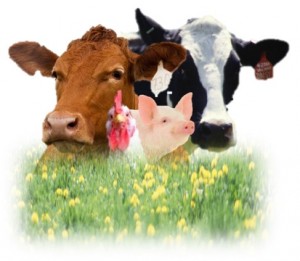California leads nation in drug resistance prevention
Dr. Michael Payne, October 11, 2015
 With the passage of Senate Bill 27, California becomes the first state in the nation to link veterinary oversight to all use of medically important antibiotics in livestock and poultry.
With the passage of Senate Bill 27, California becomes the first state in the nation to link veterinary oversight to all use of medically important antibiotics in livestock and poultry.
And that’s only part of the story…
On October 10, Governor Brown signed into law SB 27, which amends the California Food and Agricultural Code dealing with the use of antimicrobial drugs in livestock. Although the bill makes progress in preventing antibiotic resistance on a number of fronts, the centerpiece of the legislation requires a veterinarian’s order to allow a medically important antibiotic to be administered to livestock or poultry.
The issue of antibiotic resistance is one of the most complicated issues facing human and veterinary medicine, so some background is in order.

The first penicillin-resistant Staph was detected in 1945, shortly after the introduction of penicillin into hospitals.
Any time an antibiotic is administered, its use creates the potential for the target microbe to develop resistance. In fact, the first penicillin-resistant Staph was detected in 1945, shortly after the introduction of penicillin into hospitals. This potential to create antibiotic resistance occurs regardless of whether the antibiotic is used for humans, pets, livestock or crops.
The question of what percentage of antibiotics is used in animals versus humans remains hotly contested, in large part because accurate data are not easily available. Furthermore, much of the antibiotic use in animals involves compounds that have no human use or represent third-tier, antiquated antibiotics.
That said, if our goal is to extend the useful life of antibiotics, it is indisputable that in both humans and animals we need to minimize antibiotic use, and when we have to treat, we must not always reach for the biggest guns in the antibiotic arsenal.
“Prudent use of antimicrobials” has emerged as sort of a short-hand term when referring to these best management practices. For instance, if laboratory tests support it, we’re better off to treat an ear infection in a child, or pneumonia in a calf, with an early generation penicillin or tetracycline rather than with newer, high-powered fluoroquinolone or glycopeptide. Doing so saves these more important antibiotics for use in life-threatening cases.
Feeding antibiotics to livestock solely for the purpose of weight gain is not an appropriate use and a practice that the federal Food and Drug Administration (FDA) is currently in the process of eliminating. The agency is working with every manufacturer of livestock drugs to change labels used for drugs applied in feed to prohibit the use of medically important antibiotics in feed for growth promotion or feed efficiency reasons. Also being implemented are new FDA regulations that will require a Veterinary Feed Directive (VFD) any time a medically important antibiotic is used in the feed of livestock or poultry. All of these new federal regulations will go into effect late in 2016.
With the passage of SB 27, California takes prudent use of antibiotics a giant step further by requiring a veterinarian’s prescription for the use of any medically important antibiotic, not just in feed, but also if administered as a pill or as an injection. This will make California the first state to require a veterinarian’s oversight for the use of any medically important antibiotic in livestock or poultry.
Importantly, SB 27 doesn’t allow just any veterinarian to write these prescriptions. Rather, the bill requires that the prescription originates from a California veterinarian who through regular visits is familiar with the care and management practices of that particular farm. For example, this would prevent a veterinarian from Kansas from writing internet prescriptions for a California farmer. In addition, SB 27 will promote continuing education for livestock veterinarians specifically related to prevention of antibiotic resistance so they will be familiar with the latest science relative to mitigating resistance.
SB 27 has additional measures, including tracking antibiotic use in livestock and poultry, contributing to the national FDA-CDC USDA database following antibiotic resistance and promoting judicious use through the development of guidelines and outreach for farmers.
How much of a change these new laws will mean in the day-to-day life of a farmer will depend greatly on the farm itself. Many, if not most, California livestock producers already have a close relationship with their herd veterinarian, who regularly visits the farm and consults on treatment practices. These regularly scheduled visits may be as frequent as every week for a dairy or once or twice a year for cattle operations grazing in the Sierra Nevada Mountain Range. Other farms that have typically relied on using only over-the-counter antibiotics will need to develop a closer working relationship with a local veterinarian.
While additional regulations and requirements are rarely welcomed by business owners, this new approach may actually save money for many producers. Perhaps the most important service herd veterinarians provide — through post mortem examinations and lab tests – is the determination of which bacteria are present on a particular farm and the susceptibility of those strains to specific drugs. The herd vet can assist the producer in selecting antibiotic products that are the least expensive, lowest-tier drugs that will still be effective against the bugs on their farms.
Using less-expensive, but still effective, drugs and picking products that are not the biggest guns in the antibiotic arsenal ultimately will be a win-win-win for the producer, their animals and the consumer. The University of California’s School of Veterinary Medicine remains committed to assist farmers and their veterinarians and is already developing training to move forward with our shared goal of prudent use of medications in livestock.
Dr. Michael Payne is a UCD veterinarian with the School of Veterinary Medicine’s Western Institute for Food Safety and Security. He also is program director for the Industry-University-Regulatory collaboration, the California Dairy Quality Assurance Program.

